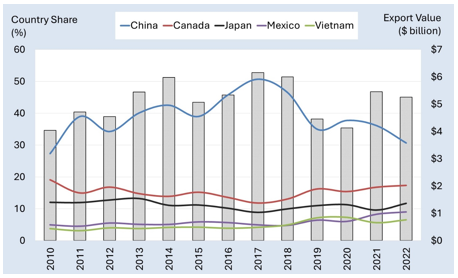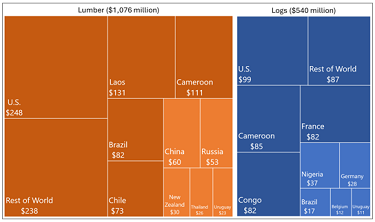
The United States supplies timber products such as logs and lumber to Asian manufacturers of finished wood products like furniture and flooring. A large share of these finished products is “reexported” to the United States or sold to other high-income countries. At the time of the 2018 trade war, the United States exported logs and lumber mostly to China and imported products like wooden furniture mostly from China (Muhammad and Jones, 2021; Jiang and Muhammad, 2024).Consequently, the tariffs imposed by the Trump administration on Chinese products indirectly decreased demand for raw materials from the United States, but the retaliatory tariffs that China then imposed on U.S. timber products decreased that demand even more. After the start of the trade war, U.S. log and lumber exports decreased by more than 25% from nearly $6.0 billion in 2018 to $4.5 billion in 2019. This overall decline was mostly due to export sales to China falling by over 40% (USDA, 2023). Consequently, U.S. timber companies are now eyeing other manufacturing hubs, like Vietnam, for export sales.
The trade war also affected U.S. importers of finished wood products and increased their reliance on Vietnam to satisfy demand. For instance, U.S. wooden furniture imports (for home use only) increased from $13 billion in 2018 to $18 billion by 2022. During this period, however, the share of imports from China decreased from 40% to 15%, while the share of imports from Vietnam increasedfrom around 26% to 40% (Jiang and Muhammad, 2024).
Undoubtedly, the trade war resulted in major shifts in U.S. trade. Vietnam has emerged as a major supplier of finished wood products to the United States and has been a consistent buyer of U.S. timber products for over a decade. However, U.S. trade relations with Vietnam have not been without controversy. For timber in particular, the United States has been concerned with Vietnam importing illegally harvested timber from high-risk countries with unsustainable forest management practices and importing or using at-risk tree species intheir manufacturing sector (USTR, 2021). In October 2020, the Office of the U.S. Trade Representative (USTR) launched a Section 301 investigation into Vietnam’s actions, policies, and practices concerning its timber imports. (Section 301 of the 1974 Trade Act grants the United States authority to address unfair trade practices.) While the act mostly addresses actions by foreign governments considered discriminatory or trade restricting, this was the first 301 investigation to address environmental concerns. Vietnam was given a reprieve to improve enforcement and monitoring of illegal timber in their supply chain. However, this issue has not been fully resolved (USTR, 2021).
In this paper, we consider an overlooked market that was significantly impacted by the trade war: timber products. We focus on Vietnam, which has potential as a major buyer of U.S. logs and lumber in the future. We also highlight the Section 301 investigation of Vietnam’s illegal timber trade, which could have resulted in restrictions on U.S. imports of finished wood products from Vietnam. We close the paper with a discussion of how agreements such as the Comprehensive and Progressive Agreement for Trans-Pacific Partnership might have addressed illegal timber harvesting and trade had the United States remained a member.

Figure 1 reports U.S. log and lumber exports and destination-country shares. From 2010 to 2017, U.S. exports increased from $4.0 billion to around $6.2 billion. Most of this growth was due to increasing export sales to China, which accounted for 27% of U.S. export sales in 2010 but more than 50% of export sales by 2017. As shown in Figure 1, the effects of the trade war were immediate. U.S. export sales declined to $4.5 billion in 2019 and then reached a low of $4.1 billion by 2020, likely the result of both the trade war and the onset of the COVID-19 pandemic. What is important to note is that export sales to China are still below pre-trade war levels, despite higher exports in 2021 and 2022 (Figure 1).
Although Vietnam imports significantly less than China (e.g., $350 million versus $1.6 billion, 2022), it has been a reliable market for U.S. timber products. Vietnam is the fifth largest foreign market for U.S. logs and lumber, accounting for around 5% of exports since 2010. The data indicate that Vietnam has become increasingly more important to the United States since the trade war. In years prior, Vietnam accounted for less than 5% of U.S. export sales. Since 2019, Vietnam has, on average, accounted for more than 7% (Figure 1).
Yellow poplar lumber is the leading U.S. timber export to Vietnam ($61 million in 2022). Other noted exports included white oak lumber ($54 million), walnut lumber ($46 million), red oak lumber ($35 million), and white oak logs ($27 million) (Table 1). For major species and products, such as poplar lumber and oak lumber, Vietnam has ranked first and third, respectively, among countries that import from the United States (USDA, 2023).
Vietnam has experienced significant growth in its demand for imported logs and lumber. Since 2012, imports have increased from around $900 million to over $1.6 billion by 2022, with some fluctuations over the intervening years. Imports from the United States have also increased over this period: $188 million in 2012 to around $350 million in 2022. Overall, the U.S. share of log and lumber imports in Vietnam has varied from about 20% (2012), decreasing to a low of 14% (2015), andthen reaching a peak of 25% (2020). In 2022, the U.S. share was around 22%. Despite these fluctuations, the growth in log and lumber imports from the United States exceeded the growth in Vietnam’s total imports (United Nations, 2023).

Currently, the United States is the largest exporter of logs and lumber to Vietnam (Figure 2). For lumber, the United States exported $248 million in 2022, accounting for 23% of total imports that year ($1.1 billion). The next two largest exporters were significantly smaller by comparison: Laos ($131 million) and Cameroon ($111 million). Other noted suppliers include Brazil ($82 million) and Chile ($73 million). Logs account for a smaller share of timber product imports in Vietnam ($540 million in 2022). While the United States is the leading log exporter to Vietnam ($99 million), it is followed closely by Cameroon ($85 million), Congo ($82
million), and France ($82 million). Imports from other competing exporters like Nigeria, Germany, Brazil, Belgium, and Uruguay ranged from $11 million to $37 million in 2022.
Illegal timber trade is the purchase of timber, including imports and exports, that has been harvested in violation of domestic or international law. Illegal timber imports in Vietnam have been a significant concern for the UnitedStates for both environmental and economic reasons. In October 2020, USTR initiated an investigation into illegal timber practices in Vietnam under Section 301 of the Trade Act. At the time, USTR indicated that evidence suggested that a significant portion of Vietnam’s timber imports was harvested or traded in violation of U.S. and international rules that protect forests and global timber resources. This issue is not solely about the environment. It has also been argued that products derived from illegally harvested timber constitutes “unfair competition” for U.S. companies (USTR, 2021).
U.S. policy, such as the Lacey Act, combats illegal trafficking of wildlife, fish, and plants (including timber),making it unlawful for the United States to importproducts from illegally harvested timber. Similar policies have been implemented in Australia and the European Union (Kim et al., 2023). As mentioned, Vietnam has emerged as a major supplier of wooden furniture and is a significant player in global wood products trade, exporting over $8.0 billion in wood products such as furniture and flooring to the U.S. annually (Jiang and Muhammad, 2024). A negative ruling would have resulted in the United States restricting or banning imports from Vietnam. This could have decreased Vietnam’s demand for imported logs and lumber, indirectly affecting U.S. exports.
After a year of discussions, the two countries were able to reach an agreement. The United States agreed not to impose tariffs or other restrictions, while Vietnam committed to improving its timber legality assurance system and enforcing laws to ensure that only legally harvested timber entered the supply chain. In addition, Vietnam promised to collaborate with high-risk countries to improve enforcement and coordination among law enforcement agencies (USTR, 2021).
This issue could be revisited by the United States ifVietnam does not remain vigilant. To prevent issues in the future, continued monitoring and collaboration between the United States and Vietnam are crucial. Vietnam has pledged to require sufficient documentation from source countries to ensure compliance and to collaborate with high-risk countries to investigate illegal activities and improve forest governance. Interestingly, China is among the high-risk source countries. Despite new regulations to clean up Vietnam’s timber sector, importers continue to bring large volumes of tropical hardwood into the country from deforestation hotspots in Africa and Asia for use in products sold domestically (Cowan, 2022).
The Trans-Pacific Partnership (TPP) negotiations started during the Bush administration. However, new countries joined, and negotiation efforts were intensified during the Obama administration. The TPP was to set economic policy in the Asia-Pacific region. Member countries included the United States and 11 Pacific Rim countries, and major U.S. trading partners such as Canada, Japan, and Mexico as well as emerging markets like Vietnam. President Obama signed the agreement in 2016, but less than a year later President Trump officially withdrew the United States from the agreement. The remaining 11 countries completed a revised agreement in 2018, renamed the Comprehensive and Progressive Agreement for Trans-Pacific Partnership (CPTPP) (Muhammad and Grant, 2021).
As part of the TPP negotiations in 2010, the United States insisted on language requiring signatories to adopt policies restricting the trade of illegally harvested timber consistent with the Lacey Act. It was understood that strong language on environmental issues was needed for the TPP to garner Democratic Party support in the United States. Interestingly, Vietnam, as well others (e.g., Malaysia, Chile), opposed the inclusion of Lacey Act provisions in the TPP. However, these countries could not override the United States. While the CPTPP provides a framework for addressing the challenges of illegal timber trade, the U.S. withdrawal allowed for the remaining countries to revise key language resulting in far less restrictive provisions on illegal logging. The most notable change is that countries are only bound by their own, less restrictive provisions and not by the Lacey Act. The TPP would have included the very rules that the United States was forced to negotiate on a bilateral basis with Vietnam. In comparing the TPP to the CPTPP, it has been argued that the change and deletion of key language was the difference between severely restricting illegal timber trade and allowing it to “flourish” (Barber and Li, 2018).
Vietnam’s role as a major importer of U.S. timber products has been solidified, driven by its expanding manufacturing base and increased demand for high-quality timber from the United States. The growth in timber trade not only benefits U.S. exporters but also supports Vietnam’s economic development goals. U.S. timber trade with Vietnam is shaped by geopolitical tensions, environmental concerns, and international agreements as they relate to Vietnam’s commitment to forest sustainability and legal timber-trade practices. As both nations navigate these challenges, the focus on sustainable development and environmental protections will be crucial for fostering a resilient and responsible wood-products trading partnership. However, addressing these challenges might have been more effective through agreements like the CPTPP.